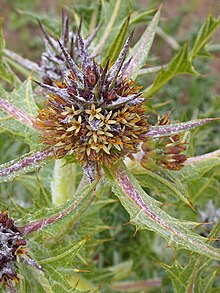Gundelia
| Gundelia | |
|---|---|
 |
|
| Gundelia tournefortii | |
| Scientific classification | |
| Kingdom: | Plantae |
| (unranked): | Angiosperms |
| (unranked): | Eudicots |
| (unranked): | Asterids |
| Order: | Asterales |
| Family: | Asteraceae |
| Tribe: | Cichorieae |
| Genus: |
Gundelia L. |
| Type species | |
|
Gundelia tournefortii L. |
|
| Synonyms | |
|
Gundelsheimera Cass. |
|
Gundelsheimera Cass.
Gundelia is a low to high (20-100 cm) thistle-like perennial herbaceous plant with latex, spiny compound inflorescences, reminiscent of teasles and eryngos, that contain cream, yellow, greenish, pink, purple or redish-purple disk florets. It is assigned to the daisy family. Flowers can be found from February to May. The stems of this plant dry-out when the seeds are ripe and break free from the underground root, and are then blown away like a tumbleweed, thus spreading the seeds effectively over large areas with little standing vegetation. This plant is native to the eastern Mediterranean and the Middle-East. Opinions differ about the number of species in Gundelia. Sometimes the genus is regarded monotypic, Gundelia tournefortii being a species with a large variability, but other authors distinguish up to nine species, differing in floret color and pubescence. Young stems are cooked and eaten in the Middle-East and are said to taste like a combination of artichoke and asparagus. The plant also contains compounds that have been demonstrated to be effective against a range of ailments. A large quantity of pollen assigned to Gundelia has been found on the Shroud of Turin, which may suggest that the crown of thorns was made from Gundelia, but this finding has been contested. In Hebrew it is called עַכּוּבִית הַגַּלְגַּל (Akuvit ha-galgal), galgal meaning "wirlwind" or "wheel", עכוב ('akoub) or כעוב (kaoub) in Arab, kereng meaning "surly" in Kurdish, kenger in Turkish, silifa in Greek, kangar in Farsi and in Armenian. The العربية (akkub) that is referred to in the Talmud is probably Gundelia. In English it is sometimes called tumble thistle or galgal.
...
Wikipedia
